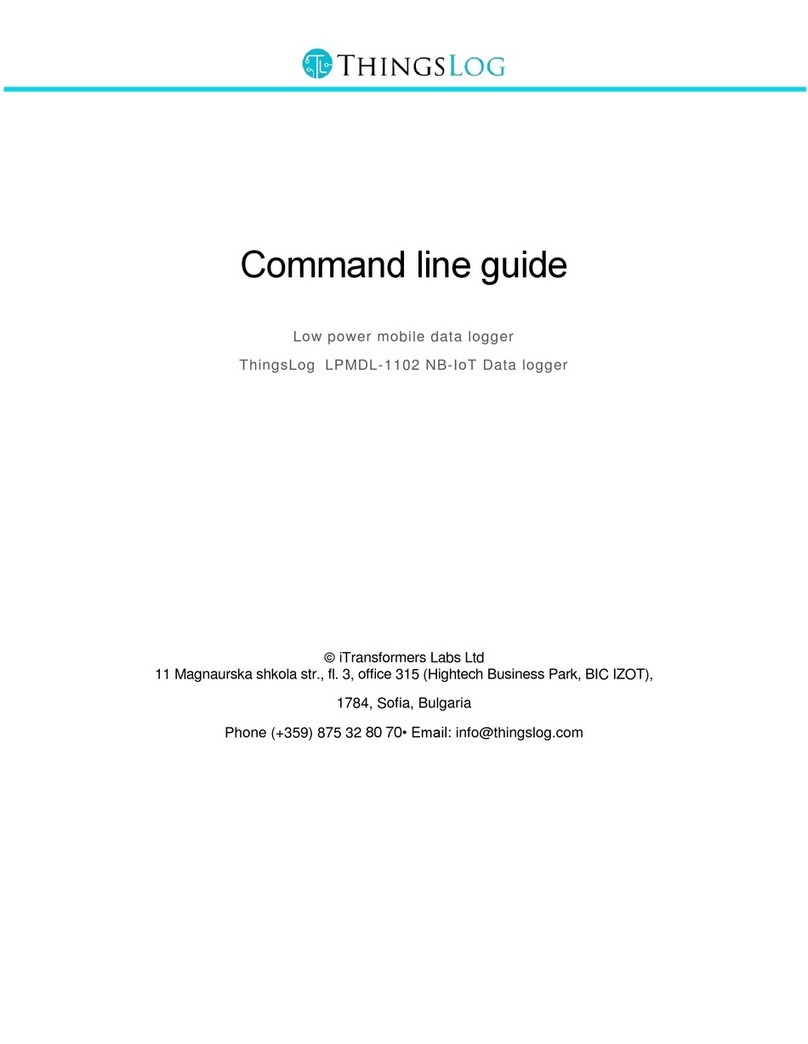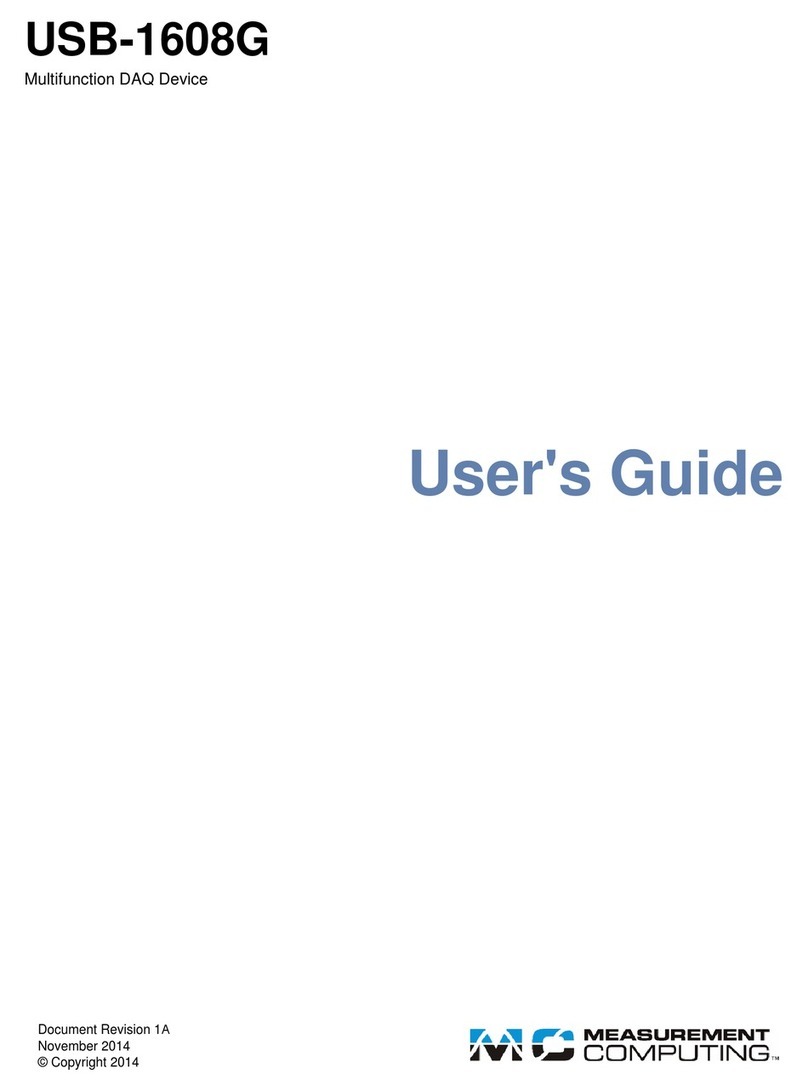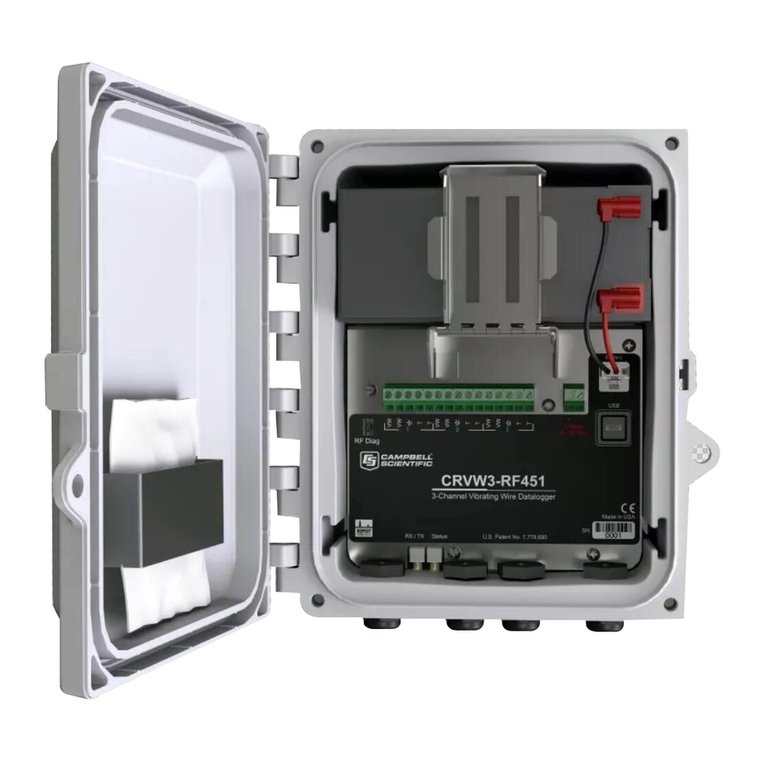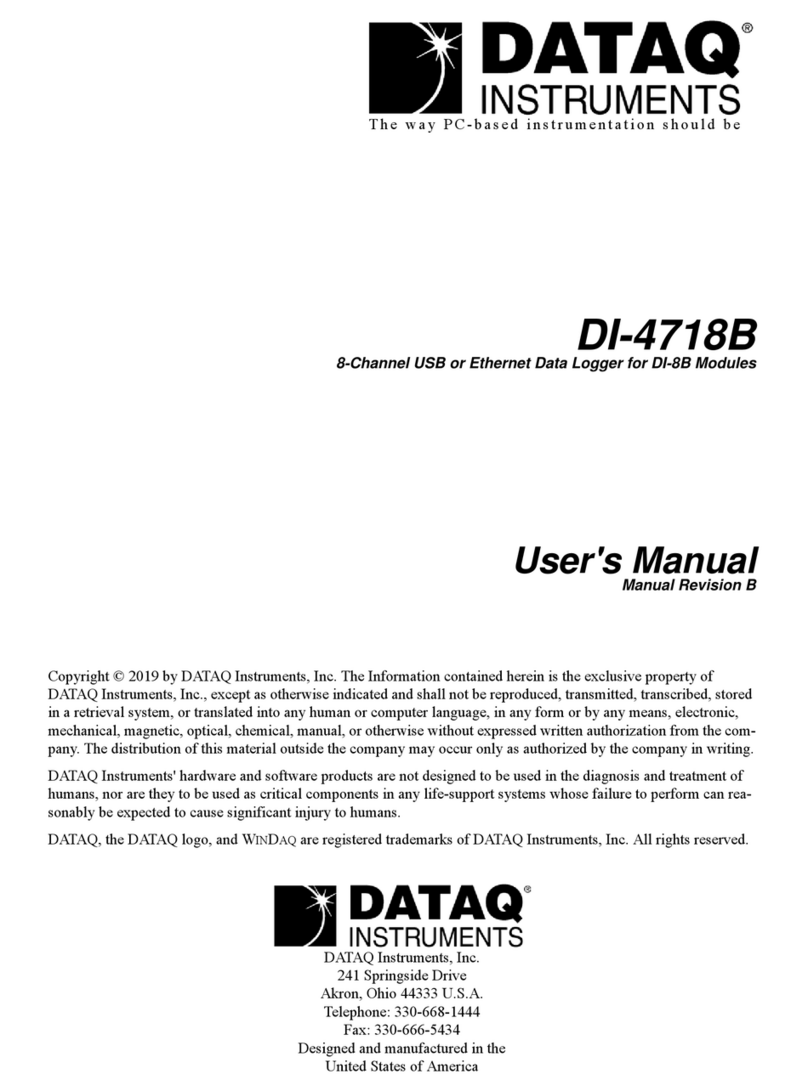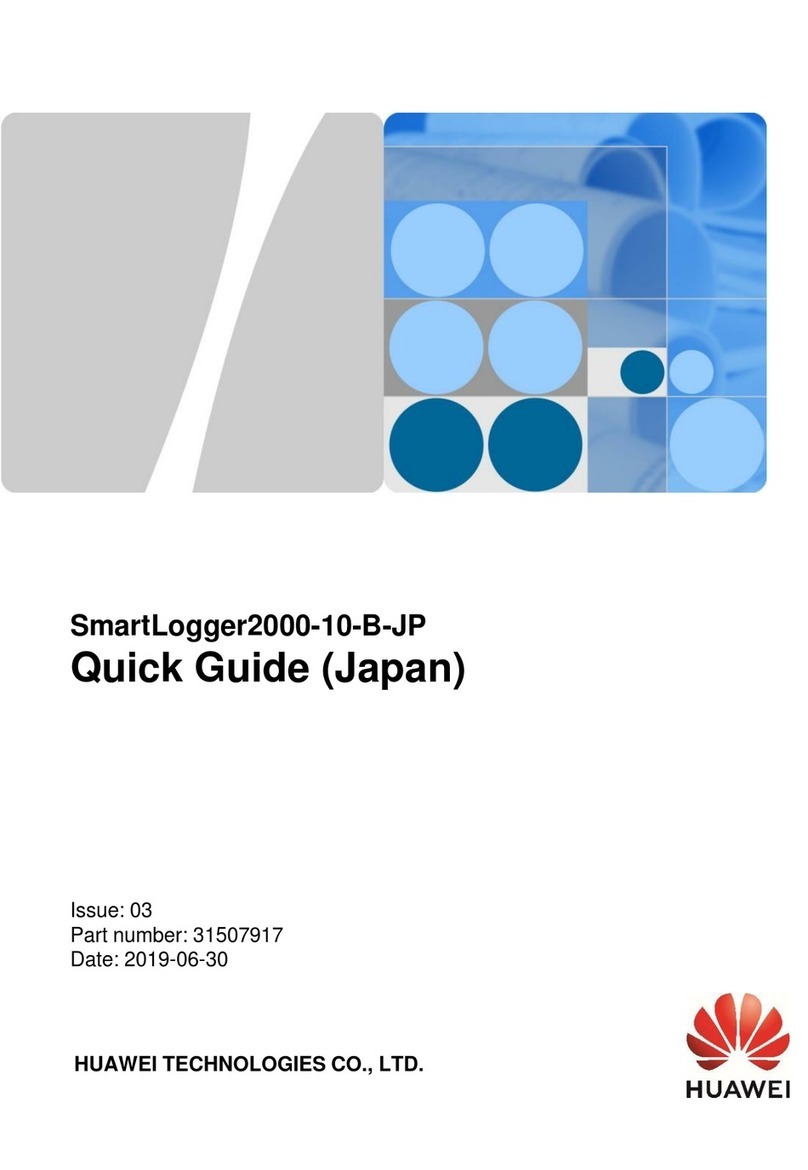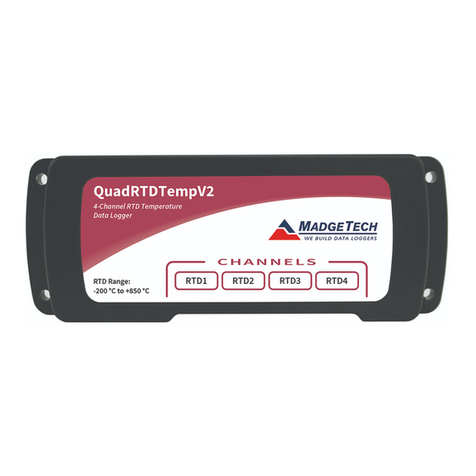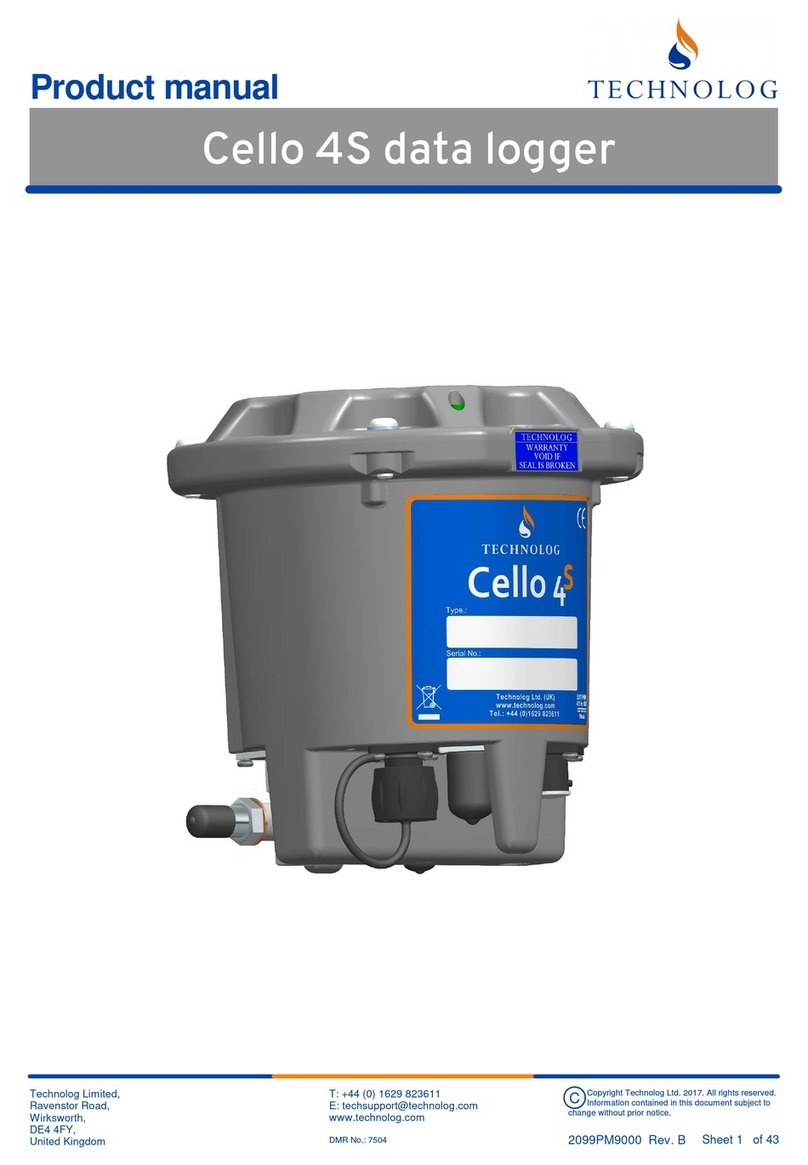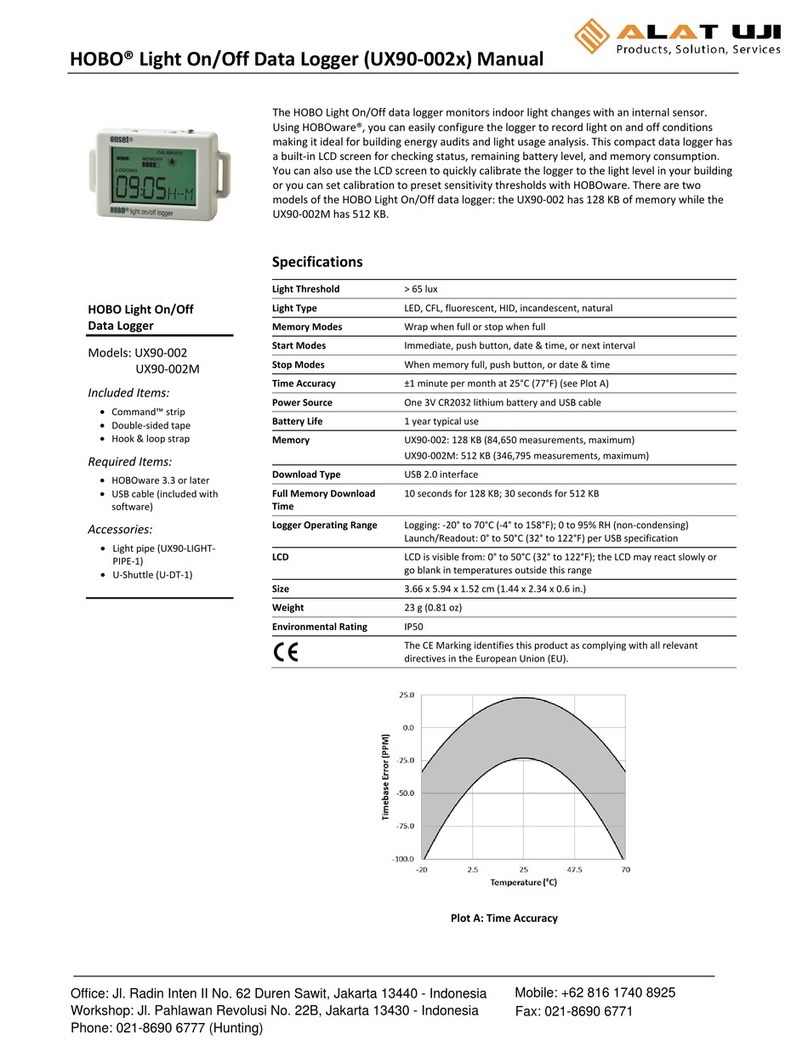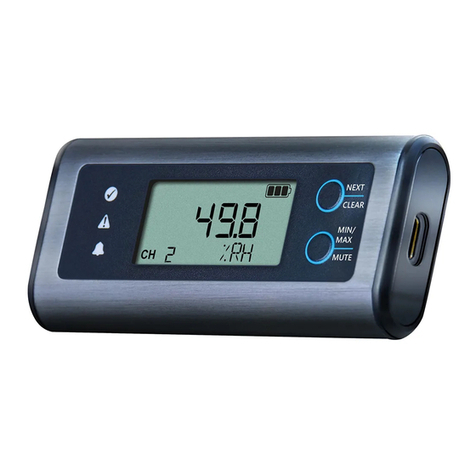GFZ DiGOS Omnirecs DATA-CUBE3 Series User manual

DiGOS Potsdam GmbH
http://digos.eu • info@digos.eu
Doc.:
DATA-CUBE-User-Manual
Issue:
1.3
Date:
15-May-2020
© DiGOS Potsdam GmbH
Page 1 / 24
Seismic Data Recorder
DATA-CUBE³
User Manual
DiGOS Potsdam GmbH
Telegrafenberg
14473 Potsdam
Germany

DATA-CUBE³ User Manual
Doc.:
DATA-CUBE-User-Manual
Issue:
1.3
Date:
15-May-2020
© DiGOS Potsdam GmbH
Page 2 / 24
Contents
1. Introduction..............................................................................................................................................3
2. DATA-CUBE³...........................................................................................................................................4
2.1. DATA-CUBE³ Type 1 (int) .......................................................................................................................4
2.2. DATA-CUBE³ Type 2 (ext) ......................................................................................................................5
2.3. Custom-built Types..................................................................................................................................5
3. Accessories .............................................................................................................................................6
3.1. Software and Configuration.....................................................................................................................6
3.2. Transport Box..........................................................................................................................................6
3.3. Breakout Box (BOB)................................................................................................................................7
3.4. Cables......................................................................................................................................................8
3.5. Geophones..............................................................................................................................................9
3.6. Mass Data Download ..............................................................................................................................9
3.7. Batteries & Power Supply........................................................................................................................9
4. Pin-out ...................................................................................................................................................10
5. Power Budget (examples).....................................................................................................................11
6. Recording Times & Data Storage..........................................................................................................12
7. Counts and Voltage...............................................................................................................................13
8. ADC Performance .................................................................................................................................14
9. Operation...............................................................................................................................................15
9.1. Configuration .........................................................................................................................................15
9.2. Getting Started in the Lab......................................................................................................................17
9.3. Field Installation.....................................................................................................................................17
9.4. LEDs......................................................................................................................................................21
9.5. Monitoring..............................................................................................................................................21
9.6. Restart while running (REED contact)...................................................................................................21
9.7. Data Download & Conversion ...............................................................................................................22
10. General Usage Information ...................................................................................................................23
10.1. Safety Instructions.................................................................................................................................23
10.2. Additional Information............................................................................................................................23
11. Technical Specifications........................................................................................................................24

DATA-CUBE³ User Manual
Doc.:
DATA-CUBE-User-Manual
Issue:
1.3
Date:
15-May-2020
© DiGOS Potsdam GmbH
Page 3 / 24
1. Introduction
The DATA-CUBE³ is a 3-channel, 24-bit seismic data recorder. It was initially developed at GFZ Potsdam until
2011, later enhanced and introduced to the international market by Omnirecs, now produced and distributed
by DiGOS. The DATA-CUBE³ is a great candidate for different seismologic applications by its unique combi-
nation of features.
This document provides an overview of the different DATA-CUBE³ types & applications, software, available
cables and sensor signal converters as well as detailed usage information.

DATA-CUBE³ User Manual
Doc.:
DATA-CUBE-User-Manual
Issue:
1.3
Date:
15-May-2020
© DiGOS Potsdam GmbH
Page 4 / 24
2. DATA-CUBE³
The DATA-CUBE³ is available as Type 1 (int) and Type 2 (ext). Choosing the right DATA-CUBE³ type depends
on the intended application and usage scenarios. Both types are electronically identical except for the internal
vs. external GPS antenna and internal/external power supply.
2.1. DATA-CUBE³ Type 1 (int)
Features:
•Internal GPS antenna located under top cover
•Internal power supply (2x D-cells for up to 2 weeks operation) or external power supply
Typical applications:
•Active seismic measurements and short campaigns with a recording time of up to ~2 weeks (continu-
ous recording of 3 channels @ 100sps using 2 D-cell alkaline batteries)
•Outdoor installation with direct visibility of GPS satellites
•Optionally: Long-term, outdoor deployments with external power supply (internal batteries are to be
removed)
•Vault or tunnel installations without continuous GPS (see 9.3 Field Installation9.3)

DATA-CUBE³ User Manual
Doc.:
DATA-CUBE-User-Manual
Issue:
1.3
Date:
15-May-2020
© DiGOS Potsdam GmbH
Page 5 / 24
2.2. DATA-CUBE³ Type 2 (ext)
Features:
•External GPS antenna
•External power supply only
Typical applications:
•Long-term, passive seismic measurement campaigns and experiments for unattended operation of up
to ~280 days (continuous recording 3 channels @ 100sps)
•Outdoor, vault or indoor installation
2.3. Custom-built Types
In the past, some users required special versions of the DATA-CUBE³ with different configurations. As an
example, the following modified types have been manufactured in medium & large quantities:
DATA-CUBE³ Type 2: Plus electronics to adapt for a dedicated sensor signal level
DATA-CUBE³ Type 2: Antarctica & desert version for -40 - +70°C temperature rating (specified)
DATA-CUBE³ Type 2: Big data version with 64GB memory (experimental / under field tests)
CUBE+: Autonomous version with telemetry, signal level adaptation, solar power supply includ-
ing charge electronics
Please contact us if you require special adaptations.

DATA-CUBE³ User Manual
Doc.:
DATA-CUBE-User-Manual
Issue:
1.3
Date:
15-May-2020
© DiGOS Potsdam GmbH
Page 6 / 24
3. Accessories
3.1. Software and Configuration
The following software tools are available and are delivered with the DATA-CUBE³ at no additional fees:
•CubeMonitor: Used to check the proper function of the DATA-CUBE³ and noise at the installation/de-
ployment site (monitor cable required). Available for Windows only.
•CubeTools: Software package to convert recorded raw data into SEG-Y or miniSEED format. Availa-
ble for Windows and Linux.
•State-of-Health routine: Used to retrieve live state-of-health data during the measurement (GPS in-
formation, state of battery, etc.).
•Example configuration file: Used as a template to create a custom configuration of the DATA-CUBE³
recorder according to the requirements of the experiment (see section 4 below).
3.2. Transport Box
Rugged and perfectly fitting transport boxes are available for comfortable and safe transport of up to 12 DATA-
CUBE³ (or 12 geophones) in the field.
Transport box for up to 12 DATA-CUBE³

DATA-CUBE³ User Manual
Doc.:
DATA-CUBE-User-Manual
Issue:
1.3
Date:
15-May-2020
© DiGOS Potsdam GmbH
Page 7 / 24
3.3. Breakout Box (BOB)
A breakout box (BOB) is necessary if the DATA-CUBE³ is used together with an active sensor. The BOB powers
the sensor and adjusts the voltage level of the sensor output to match the voltage input range of the DATA-
CUBE³. This grants maximum flexibility and allows connecting a wide range of sensors to the DATA-CUBE³
like broadband seismometers or infrasound sensors.
Photo of an example BOB and a schematic diagram to clarify individual customer requirements
The breakout boxes are custom-made by DiGOS according to the sensor output signal specification. Addi-
tionally, the breakout box can be manufactured with the correct connector for the sensor or a corresponding
socket for an already existing sensor cable.
Low power protection can be included into the BOB if required. This avoids deep discharging of an external,
rechargeable battery.
DiGOS also built BOBs with manual sensor centering support. Please ask us for a tailored quote.
Photo of an example BOB with special functions (Un-Lock, Center...) and a schematic diagram to clarify indi-
vidual customer requirements
The low power protection disconnects the load (power) at approx. 11.5V and switches off at 10V.
Please note that Geophones that are distributed by DiGOS do not require a breakout box!

DATA-CUBE³ User Manual
Doc.:
DATA-CUBE-User-Manual
Issue:
1.3
Date:
15-May-2020
© DiGOS Potsdam GmbH
Page 8 / 24
3.4. Cables
The following cables are available:
Power cable
This cable is used to feed the DATA-CUBE³ with external power (5-24V DC). The input is protected
against reverse poling. Connector and pin-out are different between DATA-CUBE³ Type 1 and 2. The
D-cell batteries must be removed when powering DATA-CUBE³ Type 1 by external power!
USB up-/download cable (light grey)
This cable is used to upload a new configuration file to the DATA-CUBE³ or to download recorded data
from the internal storage. When connecting the DATA-CUBE³ via this cable to a computer it will appear
as an external drive. It is not necessary (yet possible) to additionally power the DATA-CUBE³ when
connecting this cable. The DATA-CUBE³ will receive power from the computer via USB to enable ac-
cess to the internal storage.
Please note: Recording of the DATA-CUBE³ stops automatically when connecting this cable! For data
post-processing it is important to have a GPS fix at the end of the recording. The user must make sure
that a GPS fix is acquired before downloading the data. The recording will continue automatically when
the cable is disconnected again. It is recommended to disconnect the DATA-CUBE³ from the power
supply before downloading the measurement data and reconnect afterwards.
Monitor cable (black)
This cable is used to check the proper operation of the DATA-CUBE³ and to observe the noise level of
an installation / deployment site. The necessary software CubeMonitor is delivered with the DATA-
CUBE³ and runs on Windows only.
Sensor cable
A sensor cable is either delivered bythe sensor manufacturer or can be ordered in various lengths from
DiGOS for most common sensors. We can also offer posthole cables on customer request.
Please contact us if you require special cable modifications.

DATA-CUBE³ User Manual
Doc.:
DATA-CUBE-User-Manual
Issue:
1.3
Date:
15-May-2020
© DiGOS Potsdam GmbH
Page 9 / 24
3.5. Geophones
Different types of geophones can be ordered from DiGOS:
•Available natural frequencies: 4.5Hz, 8Hz, 10Hz or 14Hz
•1 component (vertical) or 3 components (1 vertical & 2 horizontal)
•3m cable (or custom length)
3 component geophone
The geophones are connected to the DATA-CUBE without an additional breakout box.
3.6. Mass Data Download by Parallel CUBE Downloader
A Parallel CUBE Downloader (PCD) is available for parallel data download from up to 12 DATA-CUBE³ units.
The PCD comes with a powered USB 3.0 hub and Windows/Linux software. The software detects when a
DATA-CUBE³ is connected to the PCD and automatically starts downloading the recorded data to a preconfig-
ured directory. It informs the user via LEDs when the download of a DATA-CUBE³ is completed to connect the
next unit.
Parallel CUBE Downloader (PCD)
3.7. Batteries & Power Supply
Standard batteries or power supplies are depending on the deployment settings/ requirements. Therefore, the
batteries are user obligations and are not provided by DiGOS. However, DiGOS supports and offers design,
engineering and installation for more complex multi-parameter, multi-sensor stations also as turnkey solutions.
Please contact us if you want to benefit from our expertise in your campaign, experiment or project.

DATA-CUBE³ User Manual
Doc.:
DATA-CUBE-User-Manual
Issue:
1.3
Date:
15-May-2020
© DiGOS Potsdam GmbH
Page 10 / 24
4. Pin-out
Please note: The following pin-out tables are describing the data sockets of the DATA-CUBE³!
10-way socket (female): signal input from sensor (type 1 and 2)
Pin
A
B
C
D
E
F
G
H
K
J
Signal
Ch1
Input+
Ch1
Input–
Ch2
Input+
Ch2
Input–
Ch3
Input+
Ch3
Input–
NC
Analogue
GND
NC
NC
Color
white
brown
green
yellow
grey
pink
blue
red
purple
black
Axis
vertical
north –south
east –west
7-way socket (male): USB/Terminal/External Power (type 1 and 2)
Pin
A
B
C
D
E
F
G
Signal
USB + 5V
USB + D
USB –D
GND
Terminal
Tx 3.3V
Termial Rx
3.3V
Power
5-24V DC
4-way socket (male): External Power (type 2 only)
Pin
A
B
C
D
Signal
Power
5-24V DC
NC
NC
GND
Color
brown
blue
Please note that the corresponding connectors (plugs) must have the opposite gender.

DATA-CUBE³ User Manual
Doc.:
DATA-CUBE-User-Manual
Issue:
1.3
Date:
15-May-2020
© DiGOS Potsdam GmbH
Page 11 / 24
5. Power Budget (examples)
The power budget has been estimated based on power consumption measurements of DATA-CUBE³ type 1
at laboratory conditions and on using two “Duracell Procell MN1300” batteries with a capacity of 39.6Wh.
DATA-CUBE³ type 1, measuring all 3 channels @ 100sps
GPS Cycle
GPS on
GPS on
GPS off
Sum
Runtime
F_TIME
GPS_TI
duration
duration
power
duration
Min
min
min/h
min/h
mW
days
15
5
20
40
147
11.2
15
4
16
44
140
11.8
15
3
12
48
133
12.4
30
5
10
50
129
12.8
30
4
8
52
125
13.2
30
3
6
54
122
13.5
30
2
4
56
118
14.0
59
59
59
0
219
7.5
Current while GPS on: 73mA / 219mW
Current while GPS off: 37mA / 111mW
Battery capacity: 39.6Wh
DATA-CUBE³ type 1, measuring only 1 channel @ 100sps
GPS Cycle
GPS on
GPS on
GPS off
Sum
Runtime
F_TIME
GPS_TI
duration
duration
power
duration
Min
min
min/h
min/h
mW
days
15
5
20
40
114
14.5
15
4
16
44
107
15.4
15
3
12
48
100
16.6
30
5
10
50
96
17.2
30
4
8
52
92
17.9
30
3
6
54
89
18.6
30
2
4
56
85
19.4
59
59
59
0
186
8.9
Current while GPS on: 62mA / 186mW
Current while GPS off: 26mA / 78mW
Battery capacity: 39.6Wh
Please note that the real runtime in the field can vary and is strongly depend on different parameters like
environmental temperature, real capacity and age of batteries. Please see the battery capacity vs. temperature
diagram below to estimate the runtime of the DATA-CUBE³ Type 1
Battery capacity depending on temperature for “Duracell Procell MN1300” alkaline batteries
Additionally, the values of F_TIME and GPS_TI should not be a multiple of 60. This can lead to undefined
behaviour for internal reasons.

DATA-CUBE³ User Manual
Doc.:
DATA-CUBE-User-Manual
Issue:
1.3
Date:
15-May-2020
© DiGOS Potsdam GmbH
Page 12 / 24
6. Recording Times & Data Storage
The internal data storage capacity of the DATA-CUBE³ is up to 32GB. A 16GB version is available mostly for
historic reasons. The following table provides an estimation of recorded raw data. It assumes a typical noise
level of the measured data:
3 channels @ 100 sps
1 channel @ 800 sps
~ 1.3 kB/s
~ 3.5 kB/s
~ 78 kB/min
~ 208 kB/min
~ 4.68 MB/h
~ 12.48 MB/h
~ 112.32 MB/d
~ 300 MB/d
The maximum continuous recording time is estimated from the data above:
3 channels
1 channel
100 sps
200 sps
400 sps
800 sps
16 GB (historic)
142 days
71 days
35.5 days
53.3 days
32 GB
284 days
142 days
71 days
106.7 days
Please note: The real maximum continuous recording time may be less than the values above by 2-3%. The
user must make sure to download the recorded data and clean the internal storage before the memory is filled
up. Otherwise, the DATA-CUBE³ stops recording when the internal storage is full.

DATA-CUBE³ User Manual
Doc.:
DATA-CUBE-User-Manual
Issue:
1.3
Date:
15-May-2020
© DiGOS Potsdam GmbH
Page 13 / 24
7. Counts and Voltage
The signal input range of the DATA-CUBE³ is ± 2.048V = 4.096Vpp.
For 24 Bit ADC this equals 0.000 000 244 140 625V per count at gain 1 (4.096V / 2e24).
The following table shows the volts per count for different gains:
Gain
Volts per count
1
244.140625 nV
2
122.070313 nV
4
61.035156 nV
8
30.517578 nV
16 (default)
15.258789 nV
32
7.629395 nV
64
3.814697 nV
This represents the value at the input side of the DATA-CUBE³.
Please note that if a BOB is used, the output of the sensor is calculated by multiplication with the denominator
of the dividing ratio given at the BOB. The value of the electromagnetic constant of the seismometer must be
taken into account, too, if the ground velocity is the value of interest.

DATA-CUBE³ User Manual
Doc.:
DATA-CUBE-User-Manual
Issue:
1.3
Date:
15-May-2020
© DiGOS Potsdam GmbH
Page 14 / 24
8. ADC Performance
The ADC performance is given for 100sps operation mode.
Gain 1
Gain 16
Gain 64
High Resolution SNR
125.6 dB
122.2 dB
113.5 dB
Effective Bits
22.4 Bit
21.8 Bit
20.3 Bit
Low Resolution SNR
122.6 dB
120.7 dB
113.0 dB
Effective Bits
21.9 Bit
21.5 Bit
20.2 Bit
Noise:

DATA-CUBE³ User Manual
Doc.:
DATA-CUBE-User-Manual
Issue:
1.3
Date:
15-May-2020
© DiGOS Potsdam GmbH
Page 15 / 24
9. Operation
9.1. Configuration
This is an example of a default configuration file. It is to be adapted for the experiment and uploaded to the
DATA-CUBE³ via USB before deployment in the field. Please refer to the configuration file manual for a detailed
description of the configuration file.
**********************************************************************
* *
* Configuration File for the 1 & 3 Channel DATA-CUBE *
* *
* Software V0.1 *
**********************************************************************
* Syntax: *
* - Lines beginning with a star '*' are comments (and are ignored) *
* - Empty lines are not allowed *
* - Parameter keywords are of six capitalized characters, *
* directly followed by an equal sign *
* - The parameter value starts at column #8 *
* - Line length is limited to 70 characters *
**********************************************************************
****** !!! Parameters for 3 channel Cubes only !!! ******
**********************************************************************
*
** Active Channels 1 = ch1 // 2 = ch1 & ch2 // 3 = ch1 to ch3
CH_NUM=3
*
** Amplifier Gain 1, 2, 4, 8, 16, 32 or 64
P_AMPL=16
*
** AD Converter Mode 0 = Low power // 1 = High resolution
C_MODE=0
*
** Amplifier Chopping 0 = off // 1 = on
A_CHOP=1
*
**********************************************************************
***** General parameters for 1 and 3 channel Cubes *******
**********************************************************************
*
** Project Name Project name of max. 20 characters. ONLY ASCII!!
E_NAME=N/A
*
** Sample Rate 50, 100, 200, 400, (800@1ch) sps
S_RATE=100
*
** Digital High Pass 0 = off // 1 = on
A_FILT=0
*
** FIR Filter 0 = Linear phase // 1 = Minimum phase
A_PHAS=0
*
** Time Base Correction 0 = off // 1 = PLL // 2 = DIFF
PLL_XO=0
*
** Geographic position lat, lon, alt; to speed up satellite search
*GPS_PO=>SIP+52+013+0000
*
** GPS Mode 0 = cycled // 1 = continuously
GPS_ON=0
*
** GPS & Flush Interval 3 to 60 minutes

DATA-CUBE³ User Manual
Doc.:
DATA-CUBE-User-Manual
Issue:
1.3
Date:
15-May-2020
© DiGOS Potsdam GmbH
Page 16 / 24
* (GPS interval only in cycled mode)
F_TIME=30
*
**********************************************************************
***** Parameters relevant for GPS cycled mode only *******
**********************************************************************
** GPS OFF after 0 = 'GPS_TI' // 1 = 60 GPS fixes max.'GPS_TI'
GPS_OF=0
*
** GPS ON Time: 3 to 60 minutes
GPS_TI=5
*
Notes
High resolution / C_MODE=1
The high resolution mode increases the resolution/dynamics by approx. 0.5Bit/3dB, but also increases
the power consumption of around 40-50mW. It is recommended to use this mode only if the capacity of the
batteries is still suffcient. The response is unchanged compared to the low power mode.
Amplifier Chopper
The chopper amplifier hacks the signal to rectify it synchronously after amplification. Thus, 1/f noise is largely
avoided. The switching frequency is 1.6kHz. Signal components above 1kHz can lead to aliasing.
PLL_XO=2 & PLL_XO=1
The settings should eliminate gaps by slowly matching the frequencies of the GPS-PPS and the internal oscil-
lator. The PLL_XO=2 option is valid and also used by different groups, while the PLL_XO=1 option, which
would be a full PLL implementation (phase-locked loop), is not available.

DATA-CUBE³ User Manual
Doc.:
DATA-CUBE-User-Manual
Issue:
1.3
Date:
15-May-2020
© DiGOS Potsdam GmbH
Page 17 / 24
9.2. Getting Started in the Lab
•Connect the DATA-CUBE³ via the light grey USB cable with a computer. The DATA-CUBE³ will appear
as a USB storage device and the configuration file can be accessed. If desired edit the configuration
file and change the values like sampling rate, gain, number of channels, interval of active GPS accord-
ing to your requirements. A brief description can be found in the configuration file itself. Please refer to
the configuration file manual for a detailed description.
•Safely remove the USB storage from your Windows computer or unmount the drive in Linux before
disconnecting the USB cable.
•Insert the batteries with correct polarity (DATA-CUBE³ Type 1) or connect an external power supply
(DATA-CUBE³ Type 1 or 2).
•Wait typically 3-5 minutes for reception of the GPS signal at an open sky location. When only the red
and blue LEDs are blinking at 1 sec interval the DATA-CUBE³ is operating ok. After the DATA-CUBE³
has received a GPS lock once, it can acquire data without GPS signal as well (e.g. for installations
inside tunnels or buildings). Only red LED is blinking when the GPS signal is lost.
Important notice: It is mandatory that the DATA-CUBE³ receives a GPS signal after the deploy-
ment at least once before being switched off. This allows a proper resampling in the post-pro-
cessing.
9.3. Field Installation
DATA-CUBE³ Type 1
•Insert the batteries into the battery compartment and check for correct polarity!
•Connect the sensor with the upper left socket (10-way) for data recording.
•Wait typically 3-5 minutes for reception of the GPS signal at an open sky location if the coordinates in
the configuration file match your location by a radius of about 300km. It might take much longer if for
example the coordinates do not match the values in the configuration file. Adopting the correct GPS
coordinates in the configuration file will speed up the GPS synchronization drastically.
•The DATA-CUBE³ is OK & recording when the red and the blue LEDs are blinking at 1 sec interval.
•Optionally: To check the function of the DATA-CUBE³ and to see the current noise you can connect
the black 7-way cable to the upper right socket and connect it to a laptop. The DATA-CUBE³ type 1
must be powered by internal batteries during this check. The software CubeMonitor will show the live
recorded data.
•If the correct operation of the DATA-CUBE³ has been verified, it should be wrapped into a plastic bag
and dug into a shallow hole. Make sure that the top side is uncovered! Otherwise the built-in GPS
antenna will not receive a signal.
DATA-CUBE³ Type 2
•Connect the external power supply with the DATA-CUBE³ using the 4-way socket.
•Connect the external GPS antenna using the BNC socket and place it outside if the DATA-CUBE³ will
be installed in a shelter, vault or building.
•Connect the sensor with the upper left socket (10-way) for data recording.

DATA-CUBE³ User Manual
Doc.:
DATA-CUBE-User-Manual
Issue:
1.3
Date:
15-May-2020
© DiGOS Potsdam GmbH
Page 18 / 24
•Wait typically 3-5 minutes for reception of the GPS signal if the coordinated in the con-
figuration file match your location by a radius of about 300km. It might take much longer if for example
the coordinates do not match the values in the configuration file. Adopting the correct GPS coordinates
in the configuration file will speed up the GPS synchronization drastically.
•The DATA-CUBE³ is OK & recording when the red and the blue LEDs are blinking at 1 sec interval.
•Optionally: To check the function of the DATA-CUBE³ and to see the current noise you can connect
the black monitor cable and connect it to a laptop. The software CubeMonitor will show the live data
which is recorded.
•In case the DATA-CUBE³ will be placed outside, it should be wrapped in a plastic bag. The external
power supply (e.g. battery) must be protected as well.
•Note: It is possible to supply the DATA-CUBE³ Type 1 with external power via the 7-pin connector for
a short time during the change of the internal batteries (D-cells), and keep it in function. The parallel
power supply (internal and external at the same time) should be in place only for up to ~30s.
Installation example:
All components for DATA-CUBE³ (Type 1) and Geophone installation
All components for DATA-CUBE³ (Type 2) and Geophone installation

DATA-CUBE³ User Manual
Doc.:
DATA-CUBE-User-Manual
Issue:
1.3
Date:
15-May-2020
© DiGOS Potsdam GmbH
Page 19 / 24
Connect the devices and wait until red & blue LEDs are blinking synchronously! Do not place the magnetic
GPS antenna (Type 2 only) on the DATA-CUBE!
The components are:
channel 0 –vertical (Z)
channel 1 –north (N)
channel 2 –east (E)

DATA-CUBE³ User Manual
Doc.:
DATA-CUBE-User-Manual
Issue:
1.3
Date:
15-May-2020
© DiGOS Potsdam GmbH
Page 20 / 24
Example for tunnel installation:
The DATA-CUBE³ can be used for measurements without permanent GPS reception and still get precise
timing.
The general procedure is as follows:
1. The DATA-CUBE³ has to be powered outside the tunnel until it received a GPS fix (only then the
DATA-CUBE³ starts to record data from the sensor)
2. While powered (no interruption of the power supply), the DATA-CUBE³ has to be installed inside the
tunnel.
3. The measurement must not be interrupted during installation (i.e. neither disconnect the power sup-
ply nor use the USB port for data download).
4. After the tunnel measurements are done, the DATA-CUBE³ has to be brought to the outside again
and wait for it receiving a final GPS fix.
5. Only after it has received a GPS fix, the DATA-CUBE³ can be switched off or a USB cable can be
connected for downloading data.
In post-processing with the CubeTools, cube2mseed performs a resampling of the data with the first and last
GPS fix. This is based on a linear clock drift.
Depending on the installation (e.g. larger batteries or mains power available in the tunnel), the DATA-CUBE³
Type 1, which has an internal GPS antenna and also the internal power supply by 2x d-cells, is
recommended for this application. It can *additionally* be powered externally for a short time.
This makes it possible to:
1. Use DATA-CUBE³ Type 1 with d-cells during GPS fix acquisition outdoors
2. Go in and prepare the installation
3. Connect the large external battery or the power supply to the DATA-CUBE³ while it is powered by d-
cells, and then remove the d-cells quickly (the DATA-CUBE³ can be supplied with power for a short
time by internal and external means [e.g. 30s], but not too long)
4. After measurement is done insert the d-cells again and disconnect the DATA-CUBE³ from the big
batteries or mains power supply. Then the DATA-CUBE³ must be brought back outside to receive the
GPS fix again.
This manual suits for next models
2
Table of contents
Popular Data Logger manuals by other brands
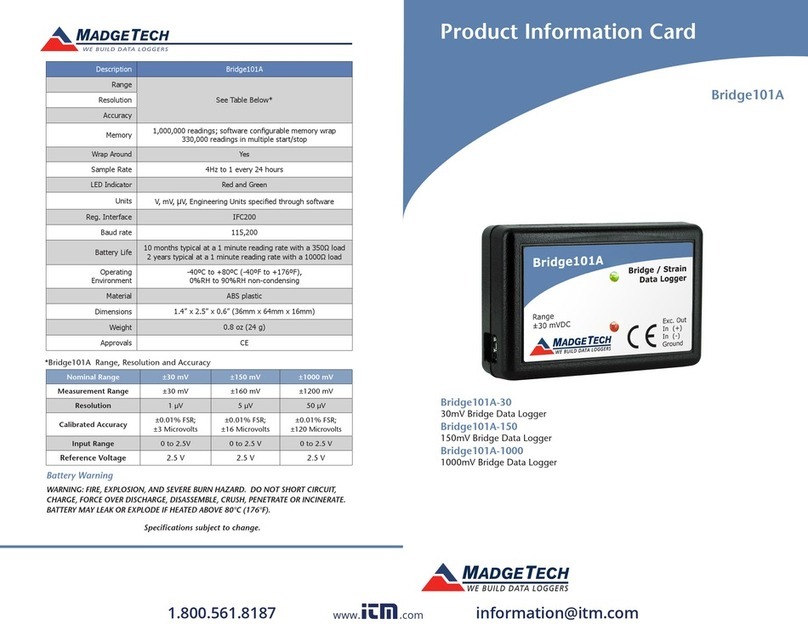
MadgeTech
MadgeTech Bridge101A-30 Product Information Card
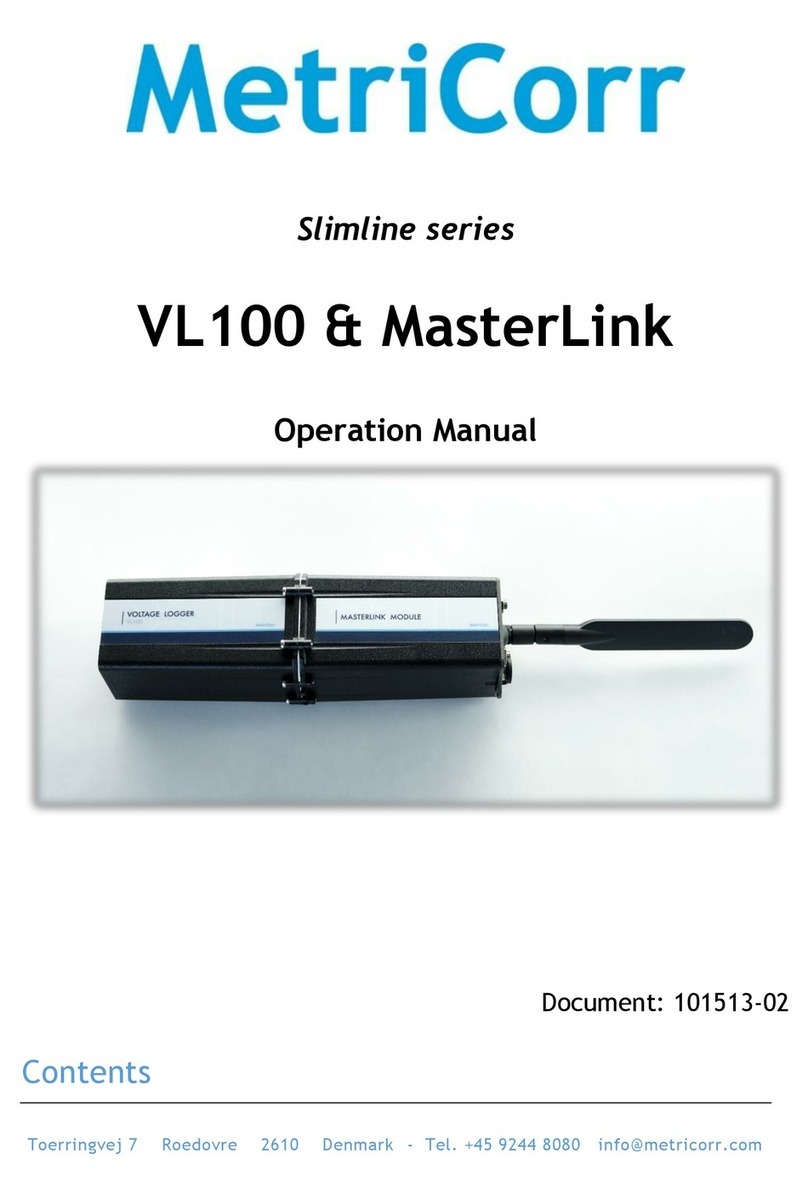
MetriCorr
MetriCorr Slimline VL100 Operation manual
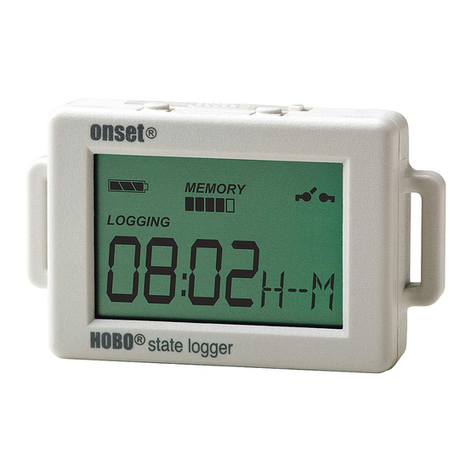
Onset
Onset Hobo UX90-001 Series manual
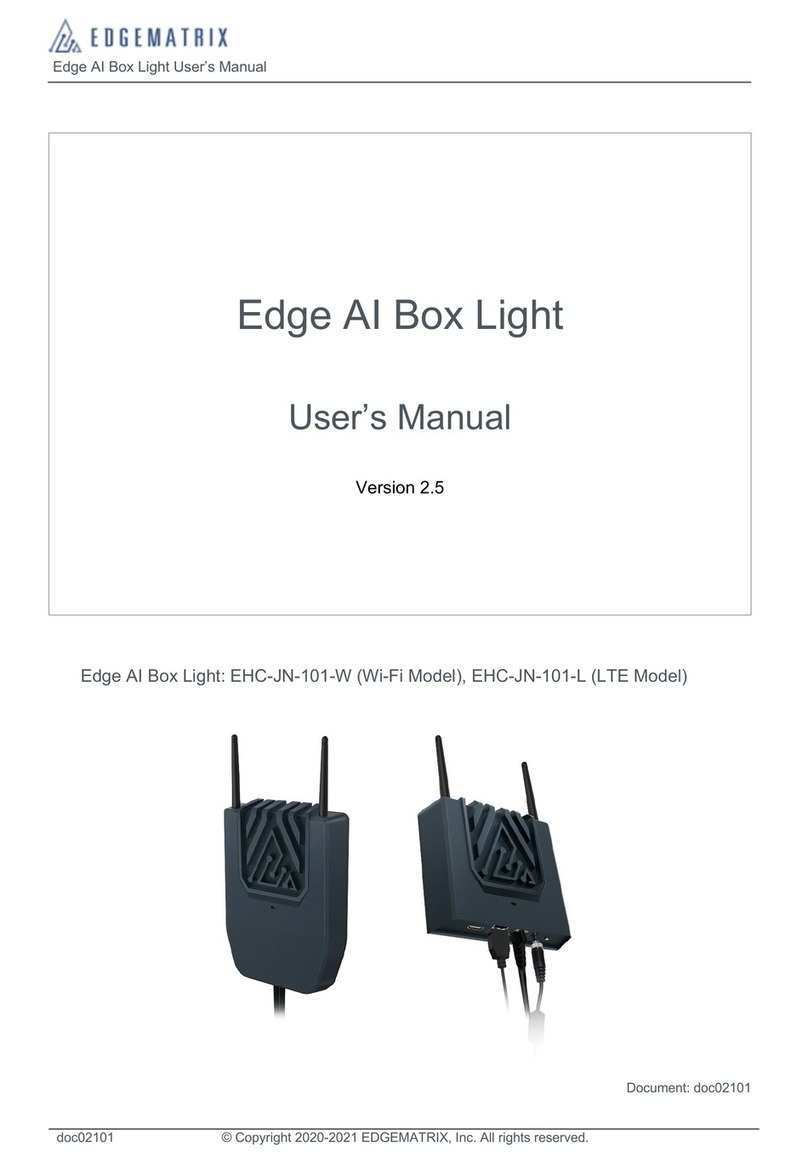
EDGEMATRIX
EDGEMATRIX Edge AI Box Light user manual

Chauvin Arnoux
Chauvin Arnoux AEMC DL913 quick start guide

Douglas Battery
Douglas Battery datatrac Installation and operation manual
